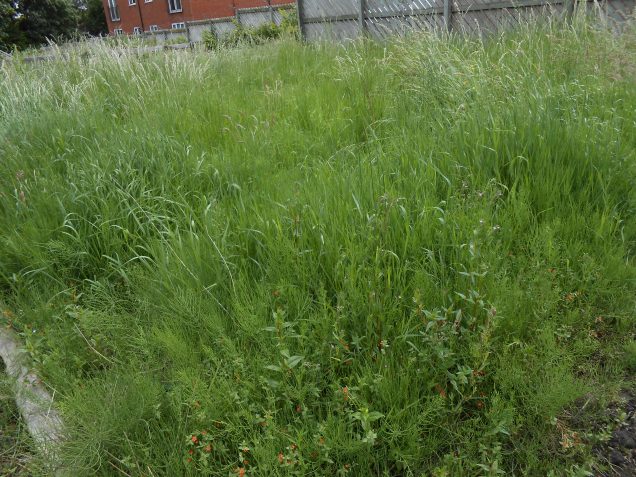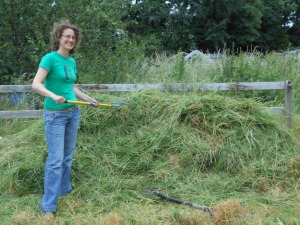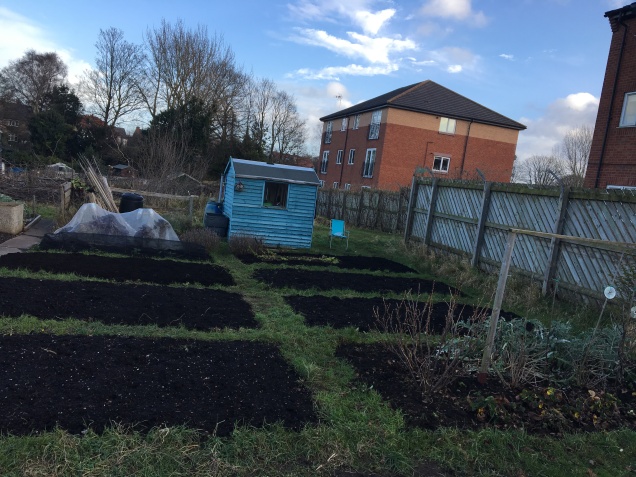Digging. An activity which for many years has been considered an essential feature of gardening, particularly in the vegetable patch. But is it all it’s cracked up to be? This blog is about the pros and cons of digging a plot, and where I am currently at in my own practice.
Digging
The first thing we did when we took on our allotment in 2012 was to dig it over. This seemed pretty much essential at the time given that it had been dormant for some while and was therefore thigh deep in Couch Grass, Horse Tail, Dandelions and pretty much every other weed one can think of: a fairly common experience for new allotment holders. Since then giving the beds an annual dig over each Spring has been established practice and I would say this has gone a long way to taming, in so far as it is possible, the rampant perennial weed cover in the actual growing areas.


Digging is certainly seen by many as an important part of maintaining a plot with a view to promoting good soil structure by reducing compaction and breaking up large clods, improving aeration, removing perennial weed roots and burying annual weeds, and allowing for the incorporation of that all important organic matter. In addition, as noted in a recent blog by Grow Like Grandad, digging is tremendous exercise and something which many gardeners actually enjoy. I would certainly put myself in that camp having always found digging an invigorating activity which is fabulously cathartic and really gets me immersed in the joys of connecting with the earth. However, having started 2018 with a 3 month old baby under my wing I recognise that the for the time being opportunities for swanning off to the allotment whenever I feel like it for half the day may be somewhat more limited. Although I am 100% committed to keeping up with our plot, in order to do so it will be necessary to work smarter. As such I decided to give some consideration to the ‘no dig’ method.
No Dig(gity)
One for fans of mid-90s floor fillers, there …
‘No dig’, as the name suggests is based on the principle of limiting cultivation in order to “disturb the soil as little as possible”. Instead a layer of organic matter, such as compost or animal manure, is added as a mulch to beds each Autumn, the idea being that it will be softened by the Winter weather before seeds are sown into this layer in the Spring. The organic matter will be slowly broken down and worked into the soil by the natural action of organisms such as earthworms, fungi and bacteria. In researching this method I found a recent blog by Stephanie Hafferty on How to Start Your No Dig Garden provided a useful overview, while I gathered more detail from ‘no dig’ pioneer Charles Dowding’s Veg Journal (2014), which as good fortune would have it was a leaving gift to my husband from his previous job. The main arguments put forward for ‘no dig’ are that it:
- is less time consuming than traditional cultivation
- results in fewer weeds to keep on top of as weed seeds are not brought to the surface by the action of cultivation and the layer of mulch also starves weed seedlings of light
- limits the “temporary harm” done to the soil by cultivation which disturbs the existing soil structure and its inhabitants
Furthermore, the research undertaken by Charles Dowding suggests that crop yields are equal to, or better than, those from traditional dug plots.
Soil and Sustainability
Coincidentally, while pondering the possibility of applying the ‘no dig’ method I have been attending classes for the RHS Level 3 module, The Root Environment, Plant Nutrition and Growing Systems at Ness Botanic Garden. As you would imagine the module syllabus includes soil and its management and this has lead to discussions about soil erosion as a consequence of human activities. It is estimated that 2.9 million tonnes of soil is eroded in the UK annually and this is seen by the UK government as a significant threat to food security. Like many other natural resources, soil has been treated as if it is an infinite commodity when in fact it can take approximately 400 years for 10mm to develop through natural processes. In this context the rate of soil erosion in the UK, never mind that in the developing world, is quite alarming. Now I realise that what I do on our little half plot allotment in Chester is hardly going change the course of world events – soil erosion on the scale being seen is somewhat more related to industrialised agricultural practices, mining and deforestation – but that does not mean that the principles of sustainable soil management should not be applied. It does seem reasonable to me that repeated digging has the potential to actually damage soil structure and subterranean ecosystems, while leaving soil bare for half the year (as happens in many a veg plot) may contribute to soil erosion, leaching of nutrients, water loss and depletion of organic matter.
Our Plot

Based on what I have read about the ‘no dig’ method I think it will require a relatively limited adjustment to my normal practice to implement at our allotment. The allotment committee arranges for a bulk order of compost derived from local authority green waste to be delivered to the colony each Autumn and I already apply this as a mulch to all of my available beds. So essentially I can continue to do this but rather than digging it in, in the Spring, I will leave it in situ and sow directly into the compost. Given that our plot is already established my understanding is that applying the compost at a depth of 2.5-5cm each year as I do currently should be sufficient, provided this is accompanied by regular hand weeding. In addition I am considering:
- expanding our composting capacity by building some additional compost bins from wooden pallets
- covering all of our current grass paths with cardboard and wood chippings as suggested in Charles Dowding’s Veg Journal in order to further suppress the spread of perennial weeds and reduce the need for regular strimming
- trying to ensure that more of the ground is occupied through the Winter with hardy crops so that less of the beds are left bare.
So for the time being I think I am sold on the idea that converting to ‘no dig’ will not only save some time in maintaining the plot, but will arguably also be better for the environment. I’d be interested to hear the views of others, whether established ‘no diggers’, committed ‘diggers’ or those pondering the pros and cons of each method.
Thanks I’m beginning to be converted too
LikeLiked by 1 person
It makes sense but I’ll reserve judgment until I’ve tried it out this year.
LikeLike
For me the “lightbulb moment” was someone saying – there is no one to dig over the soil in nature and plants grow from seed all the time. Then seeing the depth of healthy growing matter on Charles Dowding’s site clinched for me
LikeLike
Yeah, it makes sense when you think about it. Will give it a whirl this year and see how it goes.
LikeLiked by 1 person
How about the level of terrains. It will go up 6 centimetres each year. 60 in 10 years.1.20 metres in 20 years.
LikeLike
It doesn’t really work like that. I think between weathering and the action of soil organisms like worms, plus the disturbance it gets when planting and harvesting, the compost settles and the Level drops down over time.
LikeLike